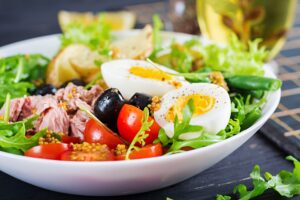Are you ready to embark on a journey towards successful weight loss through effective meal planning? Planning out your meals ahead of time can be a game-changer when it comes to achieving your health and fitness goals. By setting realistic goals, creating a weekly meal plan, and incorporating balanced nutrients, you can set yourself up for success in your weight loss journey.
Meal planning not only helps you stay on track with your nutrition, but it also saves you time and energy throughout the week. By implementing portion control strategies and tracking your progress, you can make adjustments as needed to ensure you are on the right path towards reaching your weight loss goals. With dedication and consistency, you can achieve long-lasting results and improve your overall well-being through effective meal planning.
Key Takeaways
- Create a weekly meal plan with a variety of nutritious foods
- Set realistic goals and celebrate small victories
- Track progress, make adjustments, and reflect on what worked well
- Make small changes that lead to big results and stay flexible in meal planning and exercise routine
Setting Realistic Goals
You need to set realistic goals for your weight loss journey so you can stay motivated and see lasting results. Start by assessing where you currently are and where you want to be. Set achievable milestones along the way to keep you focused and encouraged. Remember, progress is progress no matter how small, so celebrate each step you take towards your ultimate goal.
It’s important to remember that weight loss is a journey, not a race. Be patient with yourself and trust the process. By setting realistic goals, you can avoid feeling overwhelmed and give yourself the opportunity to make sustainable changes that will benefit you in the long run. Stay committed to your goals, stay positive, and believe in your ability to achieve success.
Creating a Weekly Meal Plan
When creating a weekly meal plan, it’s important to include a variety of nutritious foods to keep you satisfied and on track with your goals. Start by thinking about your favorite healthy ingredients and build your meals around them.
Include a balance of lean proteins, whole grains, fruits, and vegetables to ensure you’re getting all the essential nutrients your body needs. By incorporating different flavors and textures, you can make your meals more enjoyable and prevent boredom with your food choices.
Take some time each week to plan out your meals and snacks, taking into consideration your schedule and any upcoming events that may influence your eating habits. Preparing meals in advance can save you time and help you avoid unhealthy choices when you’re in a rush.
Remember to be flexible with your plan and allow yourself some room for indulgences or unexpected cravings. By staying organized and prepared, you can set yourself up for success in reaching your weight loss goals through effective meal planning.
Incorporating Balanced Nutrients
Incorporating a variety of nutrients in your meals is like adding different colors to a beautiful painting. Each nutrient plays a crucial role in supporting your body’s functions and maintaining overall health.
When planning your meals, aim to include a balance of carbohydrates, proteins, healthy fats, vitamins, and minerals. Carbohydrates provide energy, proteins help build and repair tissues, healthy fats support brain function, and vitamins and minerals are essential for various bodily processes. By including a variety of nutrients in your meals, you not only support your weight loss goals but also ensure that your body is receiving the necessary fuel to thrive.
When creating your meal plan, think about how you can incorporate different food groups to maximize the nutritional value of your meals. For example, include whole grains like quinoa or brown rice for carbohydrates, lean proteins like chicken or tofu, and a variety of colorful fruits and vegetables for vitamins and minerals. Don’t forget to add healthy fats like avocado or nuts to round out your meals. By focusing on balanced nutrients, you can create meals that are not only delicious but also nourishing for your body.
Portion Control Strategies
Mastering portion control is key to achieving your weight loss goals. By being mindful of how much you’re eating, you can better control your calorie intake and prevent overeating. One effective strategy is to use a smaller plate when serving yourself meals. This can help trick your mind into thinking you’re eating more than you actually are. Additionally, try to fill half of your plate with vegetables, a quarter with lean protein, and the remaining quarter with whole grains. This balanced approach ensures you’re getting the nutrients you need while still controlling your portions.
To further assist you in portion control, here is a helpful table to guide you in serving sizes:
| Food Group | Serving Size |
|---|---|
| Vegetables | 1 cup raw or 1/2 cup cooked |
| Fruits | 1 medium fruit or 1/2 cup chopped |
| Protein | 3 oz (size of a deck of cards) |
| Grains | 1 oz (size of 1 slice of bread) |
| Dairy | 1 cup milk or yogurt |
Tracking Progress and Making Adjustments
As you navigate the journey of reaching your goals, remember that tracking progress and making adjustments is like fine-tuning a musical instrument – it takes effort and precision to create the perfect harmony. Just as a musician needs to listen closely and adjust the strings to achieve the right sound, you too must pay attention to your body and tweak your strategies to see the desired results on your weight loss journey.
- Celebrate small victories along the way to stay motivated
- Reflect on what worked well and what could be improved
- Be open to trying new approaches and techniques
- Listen to your body’s feedback and make necessary adjustments
- Stay flexible and adaptable in your meal planning and exercise routine
By tracking your progress and making adjustments as needed, you can ensure that you are constantly moving forward towards your weight loss goals. Remember, it’s all about finding the right balance and making small changes that lead to big results.
Frequently Asked Questions
Can I still enjoy social gatherings and outings while following a meal plan for weight loss?
Absolutely! You can still enjoy social gatherings and outings while following a weight loss meal plan. Simply plan ahead, make healthier choices, and practice portion control. Remember, it’s about balance and enjoying yourself in moderation.
How can I prevent boredom with my meal plan and avoid falling back into old eating habits?
To prevent boredom and old habits, think of your meal plan as a garden. Just like tending to different plants, mix up your meals with variety and creativity. Watch your healthy habits grow and flourish.
Are there any specific tips for meal planning for individuals with dietary restrictions or food allergies?
When planning meals with dietary restrictions or food allergies, focus on whole foods like fruits, vegetables, lean proteins, and whole grains. Experiment with new recipes and ingredients to keep your meals exciting and satisfying.
How can I handle cravings and still stay on track with my weight loss goals?
Cravings can creep up, but conquer them with clever choices like crunchy carrots or sweet strawberries. Control cravings by creating colorful, crave-worthy meals that keep you feeling full and focused on your goals.
Is it okay to occasionally indulge in treats or high-calorie meals while following a meal plan for weight loss?
It’s okay to indulge in treats occasionally while on a weight loss meal plan. Just remember moderation is key! Enjoy your favorite foods in small portions to satisfy cravings without derailing your progress.

















